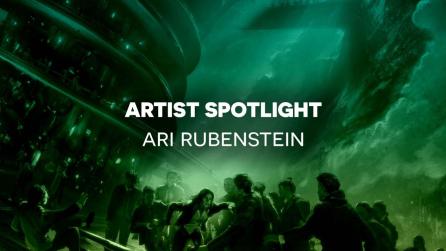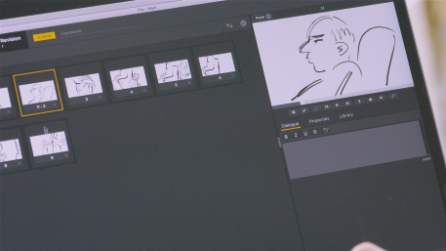Taking on sequence lighting and B*Bots with Foundry's Katana
In this digital world, most of us have imagined what it would be like if robots became sentient beings who lived alongside us. Granted, there have been some scary advances in that space and it’s hard to think about without imagining the horror of robot uprisings (thanks I, Robot), but Ron’s Gone Wrong offers us a different perspective.
The film presents us B*Bots the cuter, and in Ron’s case, slightly malfunctioning, cousin of robots, that have audiences wishing they had their own. This was largely thanks to the masterful work of DNEG Animation, who were brought on by Locksmith Animation to produce the CG imagery for the film and refine the B*Bots.
As DNEG Animation’s first feature film with a relatively new pipeline, the pressure was on, especially with the added challenges of transitioning to working-from-home, training new team members and the complex character and environment designs, which also included motion graphics elements.
“We began production for Ron’s Gone Wrong out of London with a crew of 200, and then expanded to Canada and India as shot production ramped up–and just as the pandemic hit. It was absolutely terrifying, but also exciting, and everything in between,“ Crosby Clyse, Head of Production at DNEG Animation tells us.
Despite all this, DNEG Animation rose to the challenge. Equipped with Katana, Foundry’s look development and lighting tool, they were ready to take on the opportunity to build something new at the studio and bring more feature animation work to the UK.

Bringing the B*Bots to life
DNEG Animation is a division of the global DNEG studio and as such their pipeline is built on the backbone of the existing film and episodic VFX asset pipeline. As their look development and lighting package, Katana was the core tool in this space for Ron’s Gone Wrong, enabling the team to mold it into the tool they needed for each particular workflow.
“Our development team built a system for multi-shot lighting in Katana which integrated with the studio’s asset pipe; this made it possible for lighting artists to work on multiple shots at once in a single Katana session,” Matt Waters, CG Supervisor at DNEG Animation tells us.
“It included a custom panel for viewing the shot-structure of a show much like we view a scene graph, to scope work to a particular set of shots [...] and to propagate work out to multiple shots. The benefit of having features like these is that a smaller team can work on a much larger set of shots than would otherwise be possible and we can minimize wasteful duplication of efforts.”


“There are also tremendous benefits with regards to scene management: handling and easily manipulating the extremely large amounts of data that goes into a feature animation project,” Derek Haase, Rendering Supervisor, DNEG Animation, adds.
Katana handled everything look development and lighting, from network material creation to final renders. The development team even built a custom material editing system in Katana to better mold it to their workflow. One of the interesting aspects of the team’s process on Ron’s Gone Wrong was the degree of collaboration required between multiple departments.
“The B*Bot characters had textural elements generated by animation (the facial performance for example), animated elements generated by our motion graphics team (the bots’ ‘skins’), lit elements added by lighting (textured mesh-lights representing the screen element), which all needed to be incorporated into the look-dev by our surfacing team in a dynamic way,” Matt explains.

“These contributions would go through multiple iterations, at the shot and asset level, and the surfacing needed to inherit the applicable contributions depending on the context so that a B*Bot would have the intended facial performance for a given shot. Then, in lighting, the look-dev was split into multiple render-passes and the final look was established in compositing with the help of some custom AOVs and mattes. It was a major cross-departmental effort.”
It’s clear that the collaboration effort paid off, and the DNEG Animation team was able to effectively create and refine the B*Bots and make the world fall in love with them.
Combating lighting challenges
As with every production, the team at DNEG also faced some challenges, some of these came with the team's decision to adopt USD during production.
“Moving the entire pipeline over to USD was too much of a challenge, however long term that is the direction we are headed in. Katana with its powerful APIs allowed us to “mix and match” USD and older data in Katana which has been the first step in the greater migration to USD for DNEG,” Derek tells us.

DNEG Animation ended up working with a hybrid approach on the way to full USD integration, which involved using a mixture of USD assets and Asset Packages—a DNEG specific scene description format. This ultimately helped the team manage the complexity of Ron’s Gone Wrong, with the characters, in particular, benefitting from look and geometry variant management.
What’s more, many of the characters and environments on the show had animated motion graphics elements that were integral to the performance and look of those assets. Paul Baaske, Matt and the team decided early on that they didn’t want these elements to be added in compositing—they wanted them to feel fully integrated into the scene and be visible at each stage of their pipeline so that they could inform the work, unfortunately, this did create some challenges.
“For lighting, this meant managing a high degree of complexity and collaborating closely with multiple departments, especially surfacing and motion graphics,” Matt tells us. “A particularly challenging scene was when Barney stages a prison escape for Ron from the bubble store. Beyond the many B*Bots featured in these shots—which incorporated animated textural elements generated by animators and motion graphics artists—much of the store environment is itself a dynamic, light-emitting, screen. Getting all of these elements working as intended, finding the right balance between them, and then getting the result to render in a reasonable time was no small task.”
“Full credit to the many talented artists that contributed in making this happen with a particular shout-out to the amazing motion graphics team and to my outstanding lighting team on this sequence which was led by Shaun Scott,” Matt adds.


The bubble store scene was also made up of sequences that were long, heavy, and complex, each one was comprised of several different elements which had to be managed. This included the nonsuch town environment, the dome with its animated skin, the store set-dressing—which included 4 dioramas which were like mini-environments onto themselves—plus the main characters and the crowd which included humans and various types of B*Bots.
Many of these scene elements were also sources of light that needed to be balanced with the contributions from the natural sources like the sun and sky, and the artificial sources like retail and architecture. It was more complex than any single artist could be reasonably expected to manage and so the team decided to divide and conquer.
“Typically in lighting, we will create a sequence setup and then divide the shots into similar shot groups that are assigned to artists,” Matt tells us. “For these sequences, we took it one step further and split the sequence setup work into separable location setups. Our sequence lead, Shaun Scott, managed overall integration and owned the ‘hub’ script, while our individual lighting artists, Andres Carreno, Damien Gustin, Nacho Blasco Dominguez and Sandrine Jaber, managed each of their separate ‘spoke’ setups which were referenced by the ‘hub’.

“Katana Live Groups, along with the system our Katana developers built which allowed us to scope node-graph work to a shot-group or tag, were key in enabling the success of this workflow. Each member of the team was able to push their changes to the ‘hub’ and all of their work would be reflected in the nightly keyframe renders that the lead generated. We could review these sequences holistically with the VFX Supe/client and each member of the team could address the notes that applied to their portion of the sequence setup.
“Once the sequence setup was approved we transitioned into a typical shot-lighting workflow, with each artist taking a shot group. This strategy took what seemed like a too-big-to-swallow task and divided it into many bite-sized tasks that could be accomplished by multiple contributors working simultaneously in parallel without stepping on each other’s toes. Katana is the only lighting package I have worked with so far in my career that would have enabled this strategy,” Matt continues.

A world of animation
Animation continues to increase in popularity and Ron’s Gone Wrong is a testament to the great content that is being created as a part of that. There is a need in the industry for light-hearted, family entertainment and animation and, as a result, there has been a large growth in co-production and collaboration among vendors and clients as seen with DNEG Animation and Locksmith Animation.

As the world continues towards this animated world, David Prescott, SVP Creative Production at DNEG Animation, leaves us with some advice for studios looking to start animation production:
“Build a strong relationship between the filmmakers and the CG crew at all levels—from supervisors to your young artists—so you can leverage the best out of all the teams, entrusting the work to land where it is best suited.”


